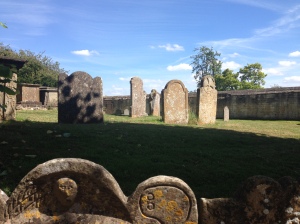I just returned from a week-long trip with my husband to the Cotswolds, one of the most stunningly beautiful and peaceful areas of England. (In fact, this collection of rural cottages, villages, farmlands, and footpaths has been officially designated an AONB: an Area of Outstanding Natural Beauty.) The Cotswolds experienced their commercial heydey during the Middle Ages, as their sheep were the sought-after source of the best wool in Europe. The cottages and towns were built, improved, and expanded during this time with the wealth acquired in the wool trade, and each village has a church that was either built or renovated during the Middle Ages, usually by the lord of the village, using wool-trade riches. These churches are beautiful, welcoming, historic, and solid.
Perhaps not surprisingly, though, time brought change to this area. The rise of cotton dealt a serious blow to the economy of the Cotswolds; these villages are now mostly run on tourist dollars and the village churches in many areas have banded together to share clergy and resources, offering services at one parish each Sunday, on a rotation.
The name Cotswold is popularly believed to be a combination of cote (enclosure) and wold (hillsides). The fields that surround the villages do host flocks of sheep and doves; sheep-cotes and dove-cotes offer shelter; trees and ruins of old manor houses provide shade to weary hikers and livestock alike. And the parish churches of The Cotswolds, too, feel like cotes — housing and protection — for those of us sheep of the Good Shepherd who wander in from the streets and fields around. The churches are cool, quiet, shaded, peaceful. Plaques and engraved stone signs tell the histories of those who worshipped, married, and were buried over the centuries. One gets a sense of the thousands of seekers and believers, the hundreds of years’ worth of song, prayer, and worship, that these churches have witnessed.
No matter the changes and chances of life — the stories of violence and suffering, forecasts of economic doom that seem to surround us — these country churches remind us that our Good Shepherd remains, and that there is always a place of shelter and protection — the same source that has been and always will be — for those who seek it, or those who stumble upon it.

May we always remember that there is shelter when we need it — whether we enter a stone church, open our Bible, or log on to the internet. The Good Shepherd will be waiting.
To learn more about the Church of England and its traditions, consider any of the following courses:
English Origins of the Book of Common Prayer
The Spirituality of the Prayer Book
Introducing Episcopal Worship
Ashley Denham Busse
Senior Course Producer





